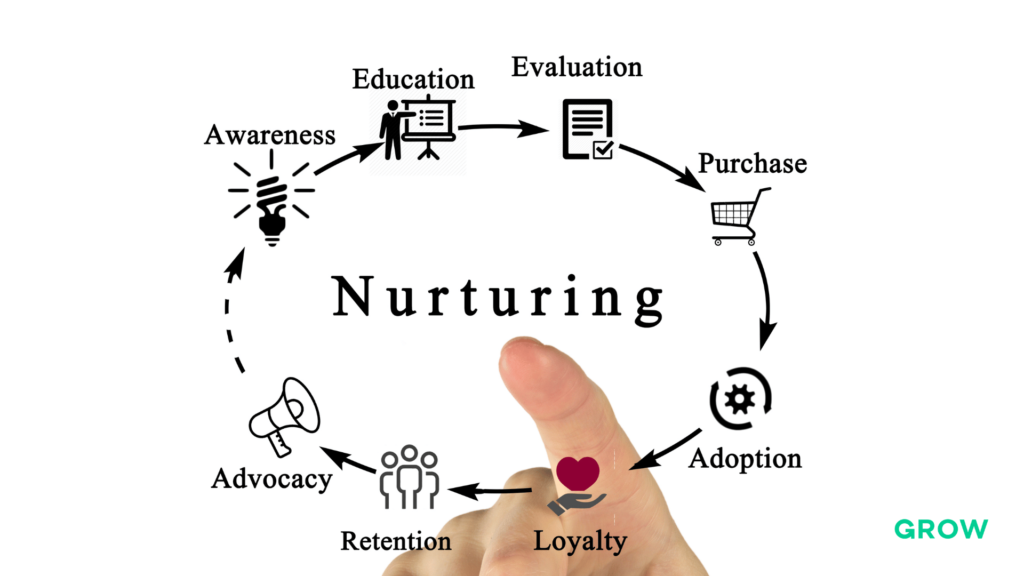Are you tired of sending emails that don’t seem to generate the desired response from your subscribers?
Do you struggle to keep your audience engaged and interested in your brand?
If so, it’s time to consider implementing an email nurturing strategy.
Email nurturing is a powerful technique that helps you build lasting relationships with your subscribers, establish trust, and ultimately drive conversions.
In this article, we’ll explore the concept of email nurturing, its benefits, and provide practical steps you can follow to create an effective nurturing campaign.
What is Email Nurturing?
Email nurturing is a series of targeted and personalised emails sent to subscribers over a specific period. The goal is to educate, engage, and guide them through the buyer’s journey, addressing their pain points, interests, and needs.
This approach helps build trust, credibility, and loyalty, ultimately leading to increased sales and customer retention.
Benefits of Email Nurturing
Improved Engagement: Personalised and relevant content encourages subscribers to open, read, and interact with your emails, increasing engagement rates.
Builds Trust: Consistent communication and valuable content help establish your brand as an authority in your industry, fostering trust and credibility.
Increased Conversions: By providing tailored content and offers, you can guide subscribers through the buying process, resulting in higher conversion rates.
Enhanced Customer Experience: Targeted messaging and timely communications contribute to a more satisfying customer experience, promoting loyalty and advocacy.
Cost-Effective: Email nurturing is a cost-effective way to reach your target audience, with minimal expenses compared to traditional marketing methods.
Steps for Creating an Effective Email Nurturing Campaign
Step 1: Define Your Objectives
Before launching an email nurturing campaign, determine what you want to achieve. Common objectives include boosting website traffic, generating leads, increasing sales, or improving customer retention.
Establish clear goals and metrics to measure success.
Step 2: Segment Your List
Segmenting your email list is crucial for creating targeted and personalised content. Categorise your subscribers based on demographics, behaviour, preferences, or purchase history.
Use segmentation to tailor your messaging and improve relevance.
Step 3: Create a Content Plan
Develop a content plan that aligns with your objectives and addresses the needs of each segment.
Consider the following elements:
Welcome Emails: Introduce new subscribers to your brand, highlight key products or services, and set expectations for future communications.
Educational Content: Provide valuable resources, such as blog articles, whitepapers, webinars, or videos, to educate subscribers about your industry, products, or services.
Promotional Offers: Share exclusive discounts, limited-time deals, or free trials to encourage subscribers to take action.
Personalised Recommendations: Use data and analytics to suggest products or services based on individual subscriber behaviours, interests, or preferences.
Exclusive Content: Offer unique content, such as early access to new products, events, or previews, to reward loyal subscribers and reinforce exclusivity.
Surveys and Feedback: Solicit feedback to better understand subscribers’ needs, preferences, and pain points, enabling you to refine your nurturing strategy.
Win-Back Campaigns: Design targeted campaigns for inactive subscribers, offering incentives to reengage and recapture interest.
Holiday and Seasonal Content: Leverage holidays and seasonal events to create themed content, promotions, or special offers that resonate with your audience.
Upselling and Cross-Selling: Present relevant upsell or cross-sell opportunities to subscribers who have previously purchased from you, maximising the customer lifetime value.

Step 4: Optimise Timing and Frequency
Determine the optimal timing and frequency for your emails, considering factors like subscriber preferences, industry trends, and competition.
Experiment with different schedules to identify what works best for your audience.
Step 5: Track and Analyse Performance
Monitor your email nurturing campaign’s performance using analytics tools. Measure open rates, click-through rates, conversion rates, and other relevant KPIs.
Adjust your strategy based on insights gained from analysing data, ensuring continuous improvement.
Best Practices for Email Nurturing
Personalisation: Use subscriber data (e.g., name, location, interests) to personalise emails, enhancing their relevance and engagement.
Relevant Content: Ensure all content is pertinent to the recipient’s stage in the buyer’s journey, interests, or pain points.
Clear Call-to-Actions: Include prominent, concise call-to-actions guiding subscribers toward the desired action.
Visual Appeal: Use high-quality visuals, graphics, and videos to break up text and enhance the email design.
Mobile Optimisation: Ensure emails display correctly across various devices and screen sizes, prioritising mobile optimisation.
A/B Testing: Regularly test subject lines, CTAs, email layouts, and other elements to identify improvements and optimise results.
Subscription Preferences: Offer subscription preference centres or opt-down options to allow subscribers control over their email frequency and content.
Unsubscribe Links: Clearly provide unsubscribe links to comply with anti-spam laws and maintain transparency.
Data Security: Protect subscriber data and adhere to privacy regulations, such as GDPR or CCPA, when storing and processing personal information.

Email nurturing is a potent tool for building strong connections with your subscribers, fostering trust, and driving conversions.
By following these practical steps and best practices, you can develop a successful email nurturing campaign that resonates with your audience and supports your business goals.
Remember to stay focused on providing value, personalising content, and optimising your strategy based on performance analysis.
FAQs
How long should my email nurturing campaign last?
The duration of your email nurturing campaign depends on various factors, including your objectives, audience, and industry. It may range from several weeks to several months or even years. Continuously evaluate and adjust your strategy based on performance and subscriber engagement.
What types of content work best for email nurturing?
Use a mix of educational, promotional, and personalised content to engage subscribers throughout the buyer’s journey. This includes blog articles, case studies, product tutorials, exclusive offers, and recommendations based on individual interests or behaviours.
How often should I send emails during a nurturing campaign?
The ideal email frequency varies depending on your audience’s preferences and expectations. Start with a moderate pace (e.g., weekly or biweekly) and adjust based on subscriber engagement and feedback. Be cautious not to overwhelm or spam your subscribers.
Can I use automation tools for email nurturing?
Yes, marketing automation platforms can streamline and optimise your email nurturing efforts. These tools enable you to personalise, schedule, and track emails, as well as score leads and trigger contextual messages. Popular automation solutions include Mailchimp, Marketo, Pardot, and HubSpot.
How do I measure the effectiveness of my email nurturing campaign?
Track key performance indicators (KPIs) such as open rates, click-through rates, conversion rates, and revenue generated. Monitoring these metrics allows you to assess the success of your campaign, pinpoint areas for improvement, and adjust strategies accordingly.




